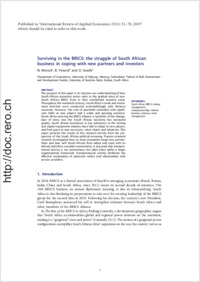3D morphology of pharyngeal dentition of the genus Capoeta (Cyprinidae): Implications for taxonomy and phylogeny
- Ayvazyan, Anna Department of Geosciences, Eberhard-Karls-University Tübingen, Germany
- Vasilyan, Davit JURASSICA Museum, Porrentruy, Switzerland - Department of Geosciences, University of Fribourg, Switzerland
- Böhme, Madelaine Department of Geosciences, Eberhard-Karls-University Tübingen, Germany - Senckenberg Center for Human Evolution and Palaeoenvironment (HEP), Tübingen, Germany
-
2019
Published in:
- Journal of Zoological Systematics and Evolutionary Research. - 2019, vol. 57, no. 1, p. 179–190
English
Capoeta is a herbivorous cyprinid fish genus, widely distributed in water bodies of Western Asia. Recent species show a distinct biogeographic pattern with endemic distribution in large fluvial drainage basins. As other cyprinids, the species of this genus are characterized by the presence of the pharyngeal bone with pharyngeal teeth. Despite this, the detailed morphology of the pharyngeal teeth, its interspecific and topologic variations, and the importance for taxonomy and phylogeny of the genus Capoeta are still not established. For the first time, a detailed comprehensive study of the pharyngeal dentition of 10 Capoeta species has been provided. The morphologic study of the pharyngeal dentition bases on the 3D microtomography and follows the purpose to evaluate the potential taxonomic and phylogenetic signals of these elements, as well as to study interspecific and topologic variations of the pharyngeal teeth. In this study, we propose a new methodology to categorize the studied pharyngeal teeth in 18 shape classes. The results of this study show that the detailed 3D morphology of the pharyngeal teeth is a useful tool for the identification of isolated teeth at the generic and/or specific level and that in certain cases, the tooth position in the teeth rows can be identified. Additionally, the preliminary analysis shows that the morphology of the pharyngeal teeth provides a potential phylogenetic signal. Both these patterns are very important for the taxonomy of cyprinid fishes and especially can be applied to fossil records.
- Faculty
- Faculté des sciences et de médecine
- Department
- Département de Géosciences
- Language
-
- English
- Classification
- Zoology
- License
-
License undefined
- Identifiers
-
- RERO DOC 324112
- DOI 10.1111/jzs.12217
- Persistent URL
- https://folia.unifr.ch/unifr/documents/307579
Statistics
Document views: 132
File downloads:
- pdf: 227
